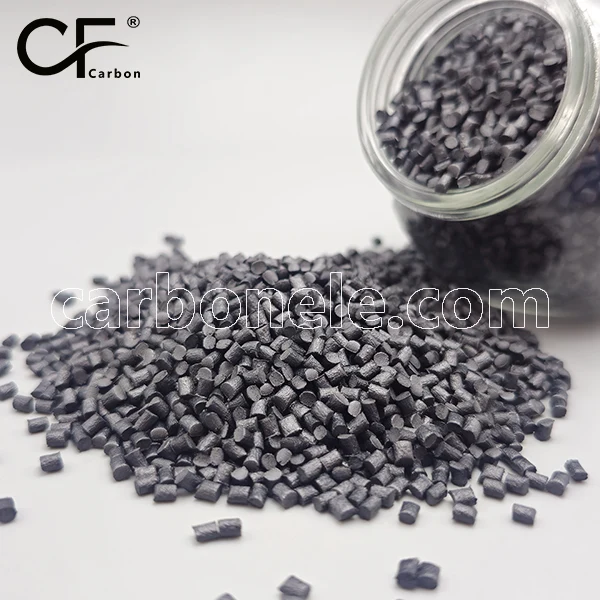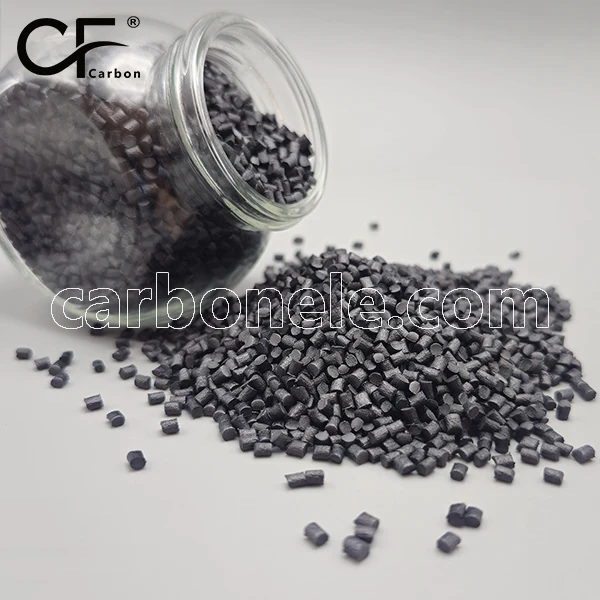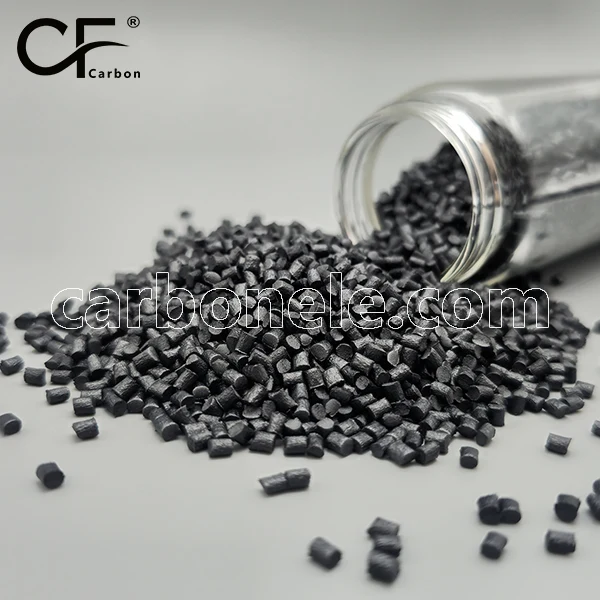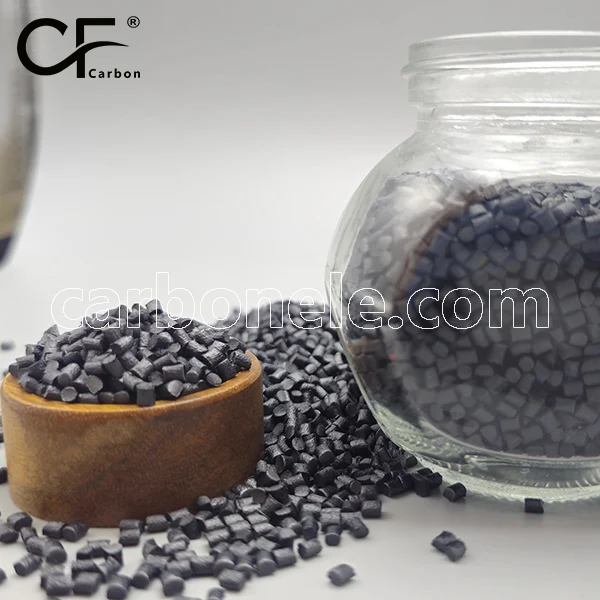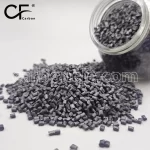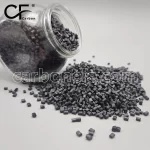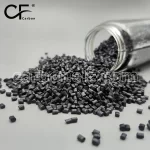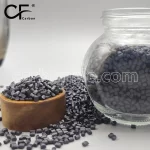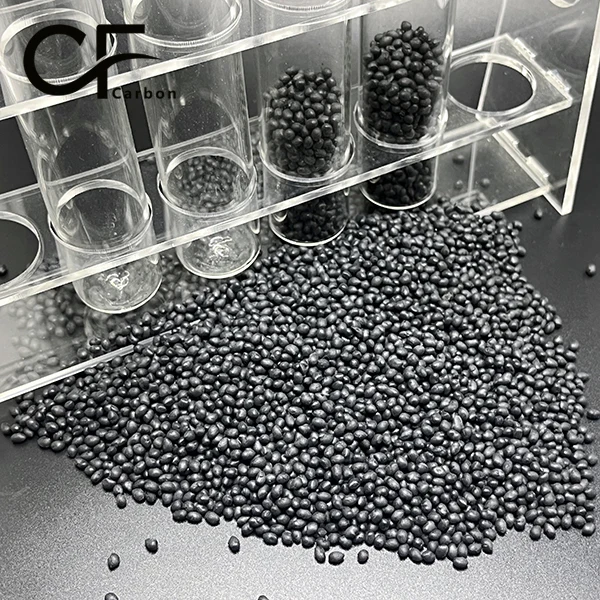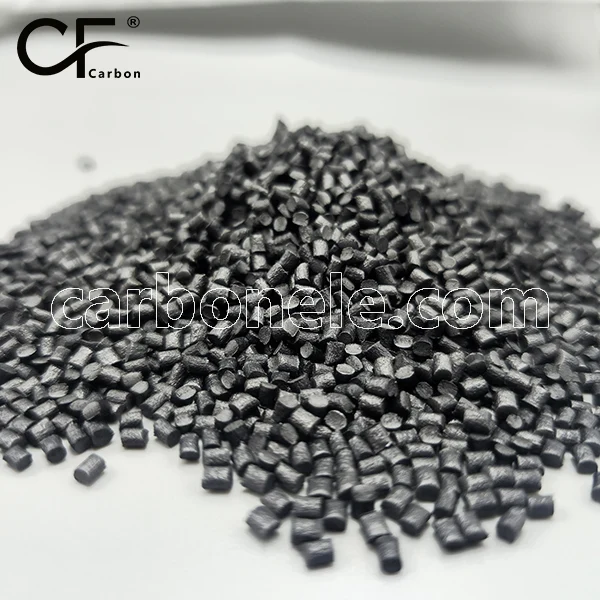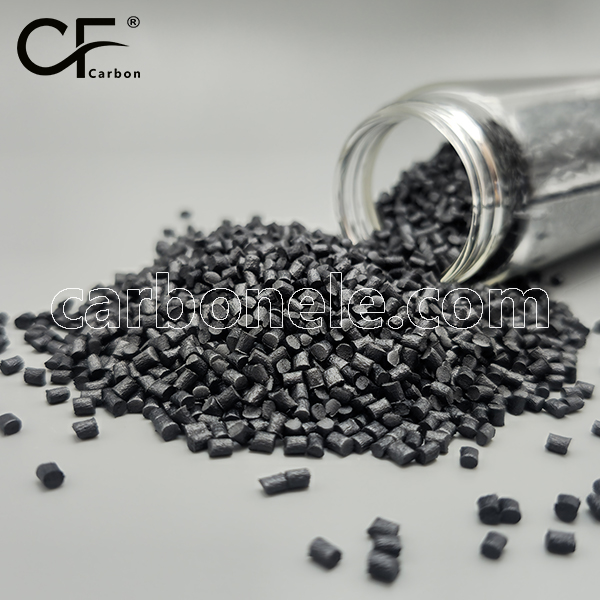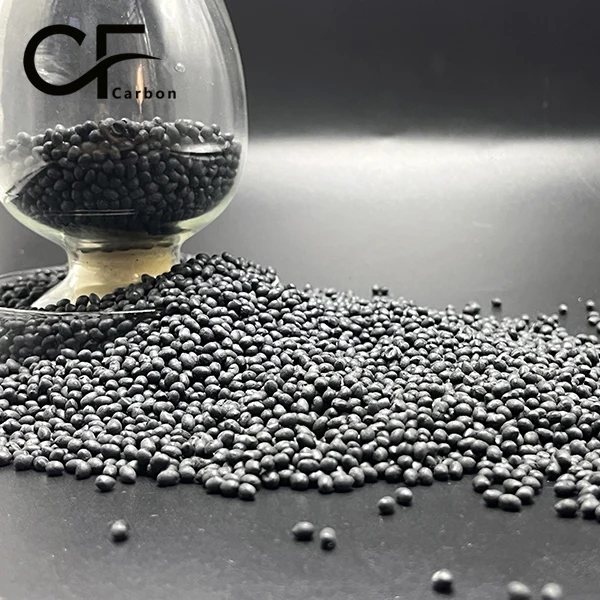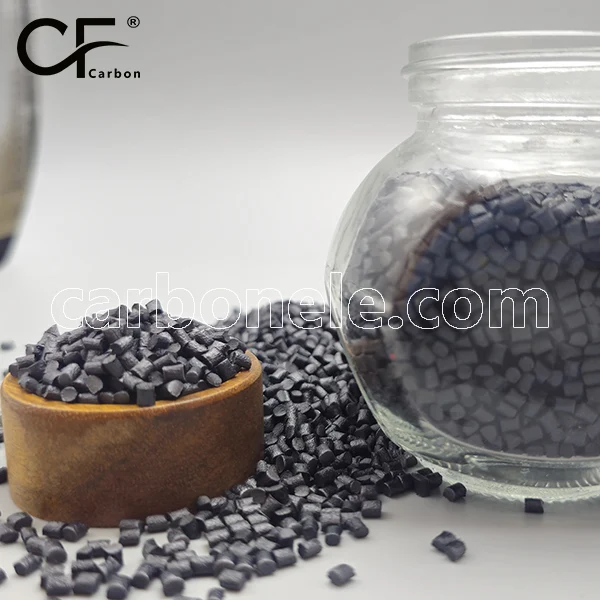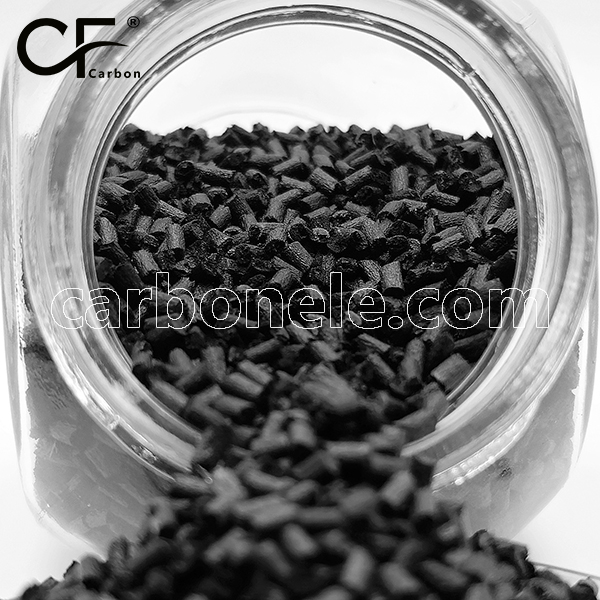
3D Filament Grade PLA CF10 Raw Material Pellets for Extrusion Line
1: Tensile strength reaches 65MPa, 42% higher than pure PLA.
2: HDT is 78℃ under 0.45MPa, 42% higher than pure PLA.
3: Flexural modulus is 4800MPa, 2.3x that of pure PLA.
4: Unnotched Izod impact strength is 9.2kJ/m², +35%.
5: MFR is 12g/10min at 190℃/2.16kg for extrusion.
- Manufacturer: Carbon New Material
- OEM/ODM: Acceptable
- Color: Black
- Free samples: ≤10kg
- MOQ: 100kg
- Port: Xiamen
- Model: PLA-CF-BCA1
- Fillers: SCF
Ⅰ. PLA CF10 Raw Material Pellets
As a composite material designed specifically for 3D Filament Grade production, PLA CF10 Raw Material Pellets take polylactic acid (PLA) as the matrix resin and are uniformly blended with 10% short carbon fiber (CF) through a specialized compounding process. The PLA component endows the material with excellent biodegradability and molding fluidity, ensuring compatibility with the continuous extrusion requirements of Extrusion Line; meanwhile, the 10% carbon fiber content significantly enhances the material’s rigidity and heat resistance, addressing the issue of easy deformation of pure PLA in 3D printing applications. PLA CF10 Raw Material Pellets feature uniform particle size, controlled within the range of 2-4mm, which can be directly fed into 3D Filament Grade dedicated Extrusion Line without additional preprocessing, providing stable raw material support for the production of 3D Filament Grade PLA CF10 wires.
Ⅱ. Key Properties of PLA CF10 Raw Material Pellets
1. Tensile Strength
When PLA CF10 Raw Material Pellets are processed into 3D Filament Grade PLA CF10 wires via Extrusion Line, the tensile strength reaches 65MPa, which is 42% higher than that of pure PLA wires. This performance meets the load-bearing requirements of 3D-printed structural parts (such as small mechanical components) and complies with the high-precision performance standards of 3D Filament Grade materials.
2. Heat Deflection Temperature (HDT)
Under a pressure of 0.45MPa, the heat deflection temperature of molded products made from PLA CF10 Raw Material Pellets is 78℃, representing a 42% increase compared to pure PLA (approximately 55℃). This enables the 3D Filament Grade PLA CF10 products to withstand slightly high-temperature environments during daily use (e.g., decorative parts near LED light sources) while ensuring dimensional stability.
3. Flexural Modulus
The flexural modulus of PLA CF10 Raw Material Pellets is 4800MPa, which is 2.3 times that of pure PLA. Bracket-like parts (such as support feet for small equipment) 3D-printed with 3D Filament Grade wires produced from this material are resistant to bending and deformation under stress, and it is compatible with the high extrusion consistency requirements of Extrusion Line.
4. Impact Strength
The unnotched Izod impact strength of PLA CF10 Raw Material Pellets reaches 9.2kJ/m², a 35% improvement over pure PLA. This prevents 3D Filament Grade PLA CF10 products from being damaged by slight collisions during assembly or transportation, thus ensuring the yield rate of downstream applications using PLA CF10 Raw Material Pellets.
5. Melt Flow Rate (MFR)
Under the conditions of 190℃ and 2.16kg, the melt flow rate of PLA CF10 Raw Material Pellets is 12g/10min, which is compatible with the conventional extrusion speed (20-30m/min) of Extrusion Line. It can stably produce 3D Filament Grade wires with diameters of 1.75mm or 3.0mm, without wire breakage or diameter fluctuation issues.
Ⅲ. Main Applications of the Material
PLA CF10 Raw Material Pellets are mainly used for the production of 3D Filament Grade wires. After being processed into 3D Filament Grade PLA CF10 wires via specialized Extrusion Line, they are widely applied in the industrial 3D printing field: for example, small plastic structural parts in the automotive industry (such as interior buckles and sensor brackets), equipment housing prototypes in the electronics industry (such as drone accessories), disposable auxiliary tools in the medical device field (such as surgical positioning models), and high-precision experimental model printing in educational and research institutions. In addition, PLA CF10 Raw Material Pellets can also be used for the production of small injection-molded parts, but their primary application direction is as raw material for 3D Filament Grade wires. The 10% carbon fiber content ratio achieves a balance between strength and printing fluency, making it compatible with most FDM 3D printers.
Ⅳ. Application Case of PLA CF10 Raw Material Pellets in Automotive 3D-Printed Accessories
A European automotive component manufacturer needed to develop a lightweight on-board sensor bracket, requiring a weight of ≤15g, long-term operating temperature resistance of 60℃, and no post-processing after printing. The manufacturer selected PLA CF10 Raw Material Pellets as the raw material, produced 3D Filament Grade PLA CF10 wires (1.75mm in diameter) through Extrusion Line, and then used an FDM 3D printer (printing speed: 60mm/s, layer height: 0.2mm) for molding. The final bracket weighed 13.8g, meeting the lightweight requirement; after being placed in a 60℃ constant temperature chamber for 72 hours, the dimensional deviation was ≤0.1mm, far lower than the 0.3mm deviation of pure PLA brackets. Furthermore, the 3D Filament Grade wires made from PLA CF10 Raw Material Pellets showed no carbon fiber agglomeration during printing, and the surface roughness of the bracket was Ra ≤3.2μm, allowing direct assembly without polishing. This case proves that PLA CF10 Raw Material Pellets can stably meet the precision and heat resistance requirements of the automotive industry for 3D-printed accessories, making it a highly compatible raw material for 3D Filament Grade wire production.
Ⅴ. Contact & Description
If you need to obtain detailed performance parameters of PLA CF10 Raw Material Pellets, production process guidance for 3D Filament Grade wires, or the latest quotation, please feel free to contact us at any time; for product technical specifications, you can click on the technical data sheet to access the complete document. It should be noted that different carbon fiber-reinforced modified thermoplastic composite materials (including products similar to PLA CF10 Raw Material Pellets) may vary in performance due to factors such as different matrix resins (e.g., PLA, ABS, PETG), carbon fiber content (e.g., 5%, 10%, 15%) and type (short-cut, continuous filament), as well as production processes (e.g., twin-screw extrusion, single-screw extrusion). The advantages of specific composite materials (such as PLA CF10 Raw Material Pellets compared to carbon fiber-reinforced ABS materials) need to be accurately evaluated based on actual application requirements (e.g., whether biodegradability is required, operating temperature range) and comparative tests with specific other carbon fiber-reinforced plastics. In addition, thermoplastic composite materials produced by different manufacturers (including raw materials for 3D Filament Grade PLA CF10 wires) may have different performance focuses. It is recommended to conduct small-batch trials before mass procurement to ensure compatibility with your Extrusion Line and downstream applications.
CFRTP VERSUS CFRP
1. CFRTP demonstrates significantly faster processing time (5 minutes) compared to CFRP (45 minutes), representing a 90% reduction in manufacturing duration. 2. In terms of recyclability, CFRTP outperforms CFRP by a large margin, scoring 9 on a 1-10 scale versus CFRP's score of 2. 3. CFRTP exhibits superior impact resistance (90 kJ/m²) compared to CFRP (65 kJ/m²), showing approximately 38% better performance in this category. 4. While CFRP has higher temperature resistance (220°C) than CFRTP (180°C), both materials maintain adequate thermal performance for most applications. 5. CFRTP offers greater design flexibility (rating of 90) compared to CFRP (rating of 60), providing more versatility in manufacturing and application scenarios.

CFRTP VS. METALS
1. CFRTP exhibits the lowest density (1.50 g/cm³) among all compared materials, significantly outperforming traditional metals like steel (7.85 g/cm³) and copper (8.96 g/cm³), and even surpassing aluminum (2.70 g/cm³) and aluminum alloy (2.80 g/cm³). 2. In terms of strength-to-weight ratio, CFRTP demonstrates superior performance at 120 kN·m/kg, more than doubling the ratio of aluminum alloy (68 kN·m/kg) and far exceeding steel (26 kN·m/kg) and copper (14 kN·m/kg). 3. While steel shows the highest stiffness (200 GPa), CFRTP (150 GPa) outperforms aluminum (70 GPa), aluminum alloy (72 GPa), and copper (110 GPa), offering a favorable balance of rigidity and lightweight properties. 4. CFRTP achieves the highest corrosion resistance rating (9 on a 1-10 scale), surpassing all other materials including aluminum alloy (8), aluminum (7), copper (6), and steel (3), making it ideal for corrosive environments.
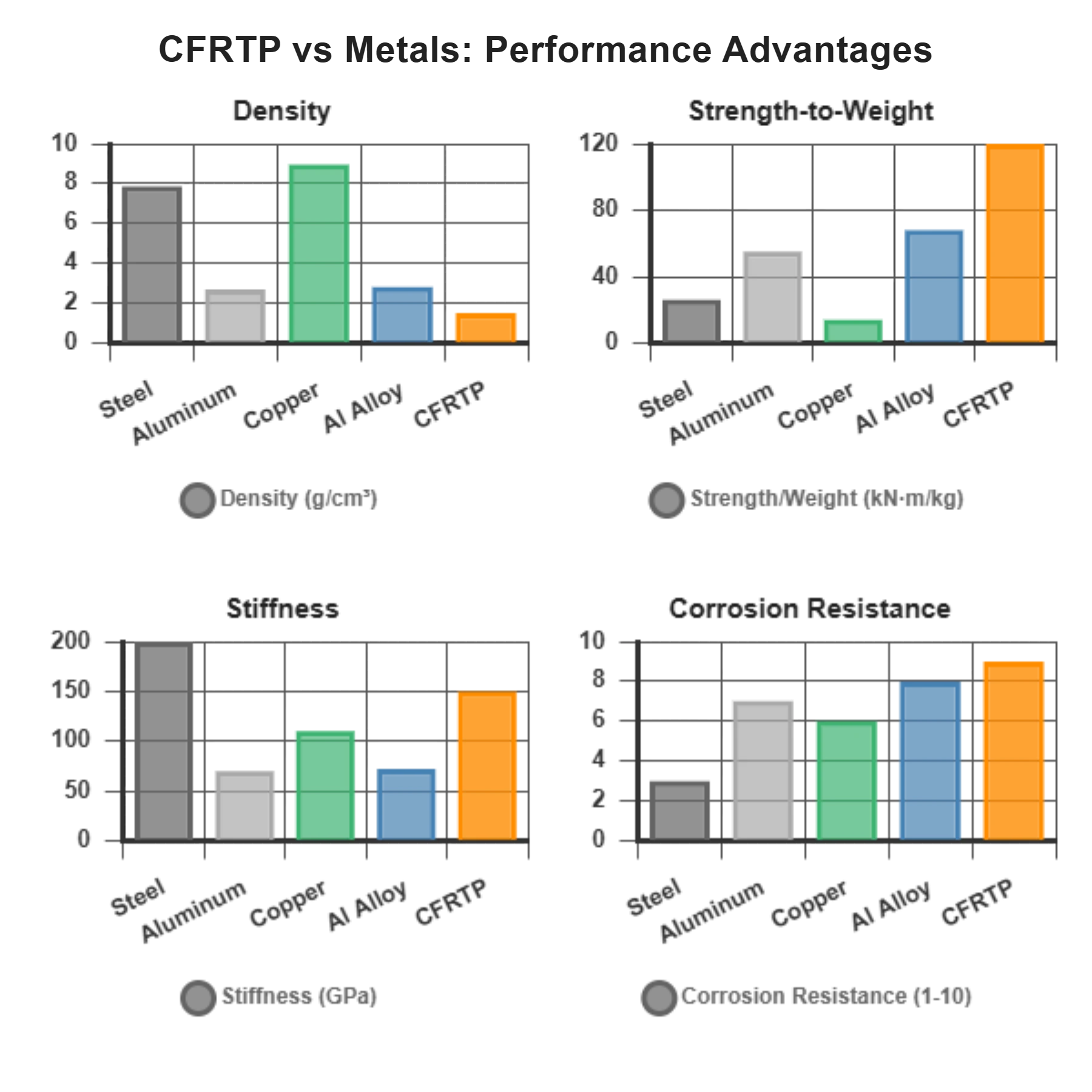
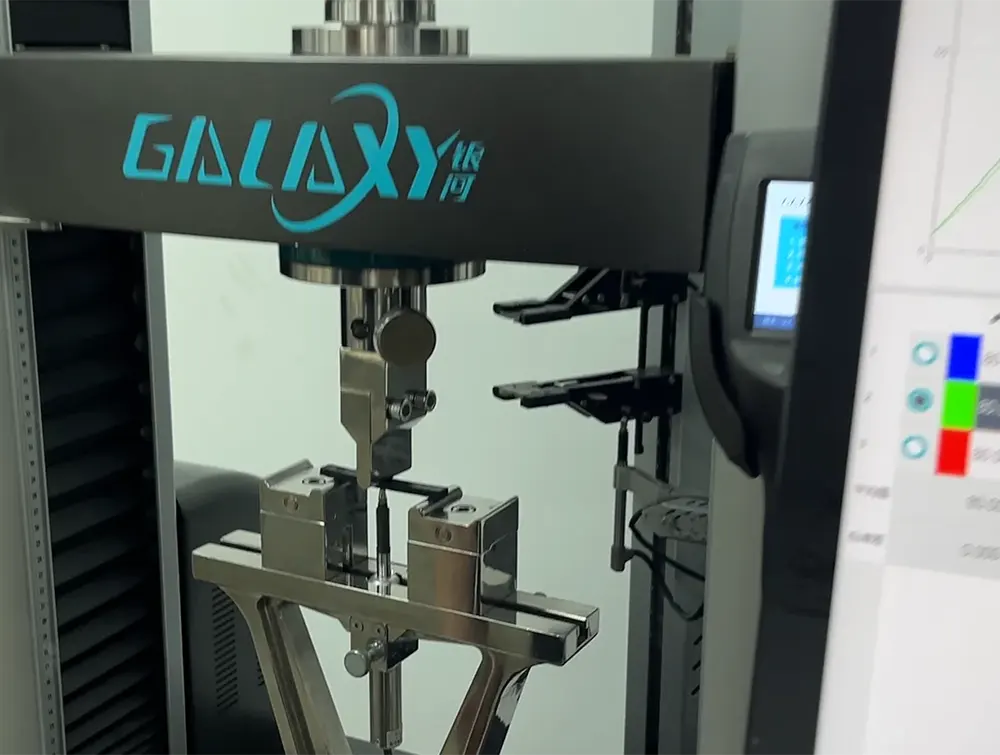

Frequently Asked Questions
Carbon (Xiamen) New Material Co., Ltd. aims to provide buyers with "one-stop" worry-free high-quality services. Here you can find all information about carbon fiber engineering plastics. If you still have questions, please send us an email for consultation!
-
How can I contact the manufacturer of a product that interests me?
When you find a product you are interested in, you can contact the manufacturer directly by sending an email and we will get back to you as soon as possible.
-
How do I find the products that interest me?
All you need to do is enter the keyword, product name in the search window and press the Enter key on your keyboard. Your search results page will then be displayed. You can also search within the product category pages on the home page. Each category is divided into subcategories, allowing you to refine your search and find products that interest you.
-
Where will I find a buying guide?
Please contact our after-sales service directly and we will provide you with a comprehensive operating guide.
-
What are CF Reinforced Thermoplastic Composites?
CF Reinforced Thermoplastic Composites are materials where carbon fibers are incorporated into a thermoplastic matrix. They combine the strength and stiffness of carbon fibers with the processability and recyclability of thermoplastics. For instance, they are used in automotive parts like bumper beams.
-
What are the benefits of CF Reinforced Thermoplastic Composites over traditional composites?
The key benefits include faster production cycles, easier recyclability, and better impact resistance. They also offer design flexibility. An example is in the manufacturing of consumer electronics casings where complex shapes can be achieved more easily.
-
How are CF Reinforced Thermoplastic Composites processed?
Common processing methods include injection molding, extrusion, and compression molding. Injection molding is widely used for mass production. For example, in the production of small components for the medical industry.
-
What industries use CF Reinforced Thermoplastic Composites?
They are utilized in aerospace, automotive, medical, and sports equipment industries. In aerospace, they can be found in interior components. In the medical field, they might be used in prosthetics.
-
How does the carbon fiber content affect the properties of the composites?
Higher carbon fiber content generally leads to increased strength and stiffness but may reduce ductility. A moderate content is often balanced for specific applications. For example, a higher content might be preferred in structural parts of a race car.
-
What are the challenges in using CF Reinforced Thermoplastic Composites?
Challenges include higher material costs, complex processing equipment requirements, and ensuring uniform fiber dispersion. Issues with adhesion between the fibers and the matrix can also arise. An example is in achieving consistent quality in large-scale production.







